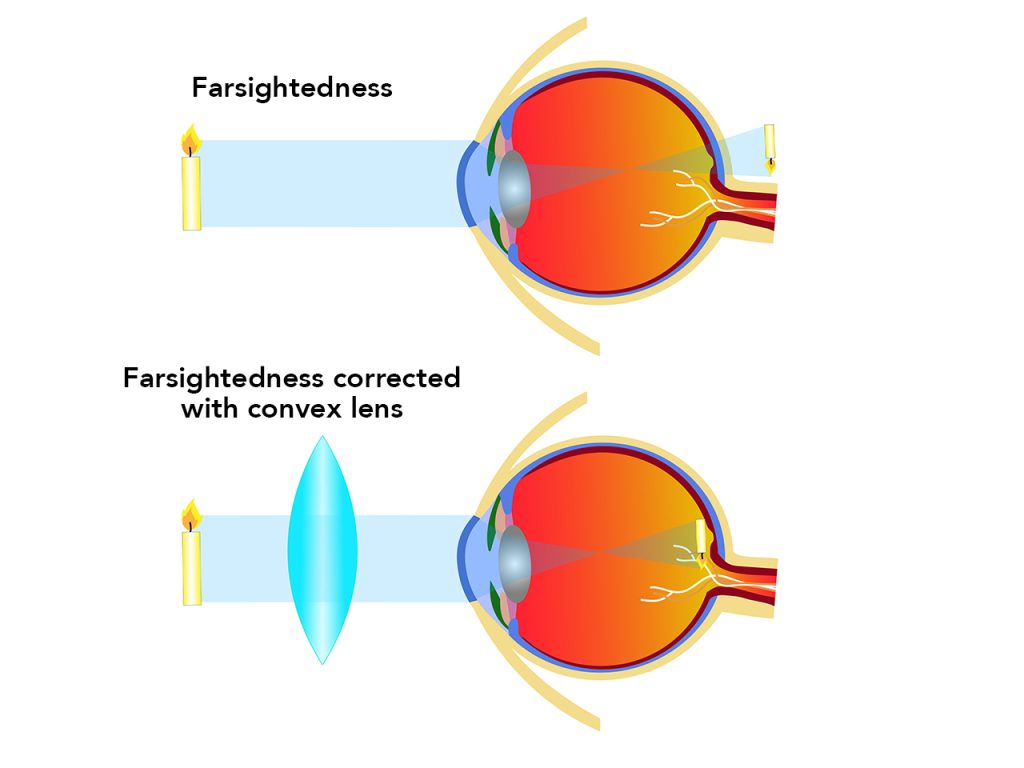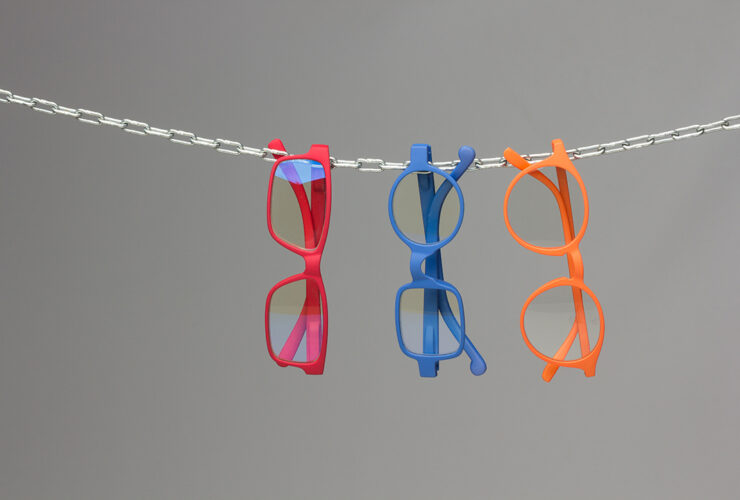At Modern Vision Solutions, our focus is on improving visual acuity and quality of life for our clients. Hyperopia, commonly known as farsightedness, affects one’s ability to see objects at close range clearly. This article will explain how glasses correct farsightedness and improve visual perception with glasses and contacts to make life more vibrant and clear. We will discuss how corrective lenses function to correct farsightedness and their importance in improving your visual clarity. The Modern Vision Solutions team is dedicated to providing options that not only improve your sight but also enhance your daily life through better vision.
How do glasses correct farsightedness?
Glasses correct farsightedness (hyperopia) using convex lenses, which are thicker in the center and bend light rays inward, increasing their convergence. This process focuses light directly onto the retina, addressing the common issue in hyperopia where light focuses behind the retina due to the eye being shorter or the cornea too flat. The use of convex lenses in glasses refracts the light correctly, allowing clear vision of near objects. These lenses have a positive power that redirects incoming light rays to focus properly on the retina, enabling individuals with hyperopia to see both nearby and distant objects clearly.

The refraction process, a fundamental aspect of determining the right eyeglass prescription, accurately assesses how light rays bend when entering the eye, ensuring the correction aligns perfectly with the individual’s visual needs. Modern Vision Solutions provides these corrective eyewear solutions, aiming to enhance visual accuracy and quality of life for farsighted individuals.
What are convex lenses?
Convex lenses, or converging lenses, are optical devices designed to converge parallel rays of light toward a single focal point. Their distinctive shape, thicker in the center and narrowing toward the edges, facilitates this convergence. When light rays enter a convex lens, they bend towards each other and meet at a focal point on the lens’s far side. This feature is leveraged in various applications, such as correcting farsightedness (hyperopia) in eyeglasses, focusing light in cameras to produce sharp images, and enlarging objects in magnifying glasses when viewed closer than the lens’s focal length.
Constructed from materials like glass or transparent plastic, convex lenses vary in type based on their surface curvature and design. Key varieties include plano-convex, with one flat and one spherical surface; double convex, where both surfaces are curved outward; and concave-convex or meniscus lenses, which have one inward and one outward curved surface. Each type serves distinct purposes, chosen for their specific focal lengths and ability to correct optical aberrations.
The focal length of a convex lens, the measure from its center to the convergence point of parallel rays, depends on the curvature and refractive index of the lens material. These lenses are essential in many optical instruments, such as telescopes, microscopes, and the human eye itself, where they are pivotal in focusing light to create clear images. Modern Vision Solutions utilizes these lenses’ properties to enhance visual clarity for individuals with vision impairments like farsightedness.
What causes farsightedness?
Farsightedness, or hyperopia, occurs when the eye’s shape prevents light from focusing directly on the retina. This issue can develop if the eyeball is shorter than normal from front to back, or if the cornea—the clear, front layer of the eye—lacks sufficient curvature. Consequently, light that enters the eye focuses behind the retina rather than on its surface, leading to blurred vision of nearby objects. Many individuals with farsightedness are born with this condition and may not experience significant vision problems until later in life. Genetic factors contribute to its occurrence, with a higher likelihood of developing hyperopia if it is prevalent in the family. Environmental influences and certain medical conditions, such as diabetes or cardiovascular diseases, also play a role in the onset or worsening of farsightedness. Modern Vision Solutions recognizes these factors in its approach to diagnosing and treating hyperopia, providing customized solutions for each individual’s visual needs.
Clear Vision Ahead: Understanding and Correcting Farsightedness
Farsightedness or hyperopia impacts 5-10% of the US population, limiting their ability to see the world clearly. Modern Vision Solutions is here to assist, offering state-of-the-art eyewear solutions tailored to correct this common visual impairment. Our all-digital eye exams and expertise in using convex lenses ensures that you receive the best care and achieve optimal vision. Don’t let farsightedness blur your life’s moments. Contact us today at Modern Vision Solutions for a comprehensive eye examination and discover how we can bring your world into clearer focus.
More FAQ’s About How Glasses Correct Farsightedness
What type of glasses lens is best for farsightedness?
Modern Vision Solutions recommends convex lenses for farsightedness. These lenses are thicker in the center, helping to focus light on the retina and clear near vision.
How long does it take to adjust to glasses for farsightedness?
At Modern Vision Solutions, we find most clients adjust to their new glasses within a few days to two weeks. Your eyes and brain need time to adapt to the change in vision correction.
Can glasses fully correct farsightedness?
Glasses from Modern Vision Solutions can effectively correct farsightedness, enabling clear near and distance vision. However, the extent of correction depends on individual eye conditions.
Do glasses for farsightedness make your eyes look bigger?
Glasses with convex lenses used for farsightedness can slightly magnify the appearance of the eyes. Modern Vision Solutions offers various lens options to minimize this effect.
Are bifocals necessary for farsightedness?
Bifocals at Modern Vision Solutions are recommended if you have farsightedness and also need different eyeglass prescription strengths for distance and close-up tasks.
How often should farsighted individuals replace their glasses?
We suggest at Modern Vision Solutions that individuals with farsightedness have their vision checked annually by their eye doctor, with lens updates as needed based on their eye health and prescription changes.
Can children outgrow farsightedness?
Some children may outgrow mild far-sightedness as their eyes develop. Modern Vision Solutions monitors young clients’ vision closely to adjust their prescription as needed.
Is farsightedness more common than nearsightedness?
Farsightedness is less common than near-sightedness. At Modern Vision Solutions, we provide thorough assessments to determine each individual’s specific vision needs.
Can wearing glasses for farsightedness worsen vision over time?
No, wearing glasses prescribed by Modern Vision Solutions corrects your vision and does not worsen it. Regular eye exams ensure your prescription remains optimal.
What are the signs and symptoms that my farsightedness is getting worse?
Increasing difficulty with near vision tasks, such as reading or using a computer, squinting to see clearly, eye strain, and headaches may indicate your farsightedness is worsening. Regular check-ups at Modern Vision Solutions can help manage your vision changes effectively. Our expertise in optometry ensures comprehensive care for our patients.
Can LASIK or other refractive surgeries correct presbyopia and farsightedness?
LASIK, along with other forms of refractive surgery like photorefractive keratectomy (PRK) and keratomileusis, are commonly used to correct refractive errors, including farsightedness. However, presbyopia, which often occurs with age, requires specialized surgical approaches other than laser surgery. Ophthalmology experts at Modern Vision Solutions utilize advanced eye surgery techniques to tailor the treatment to the individual’s vision needs. These procedures reshape the cornea, addressing the underlying refractive error, and can be an effective solution for those seeking alternatives to glasses or contact lenses.











